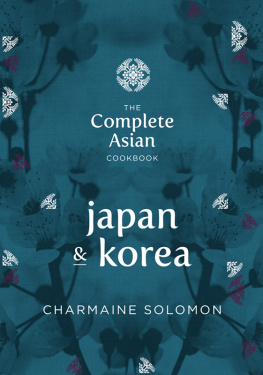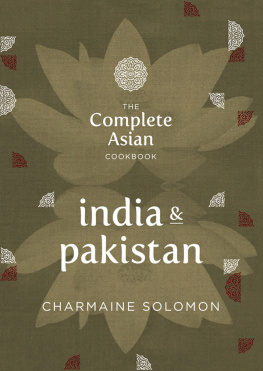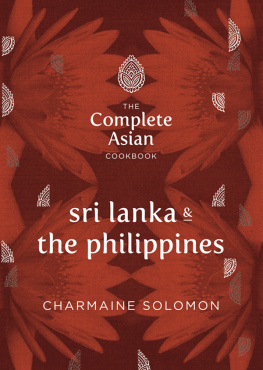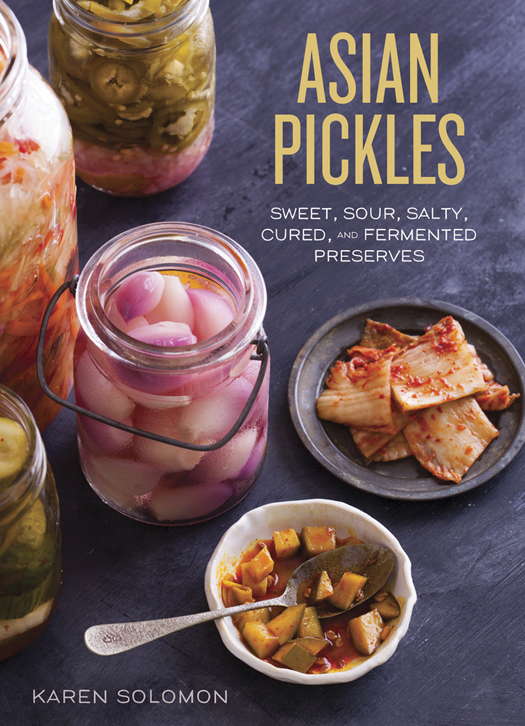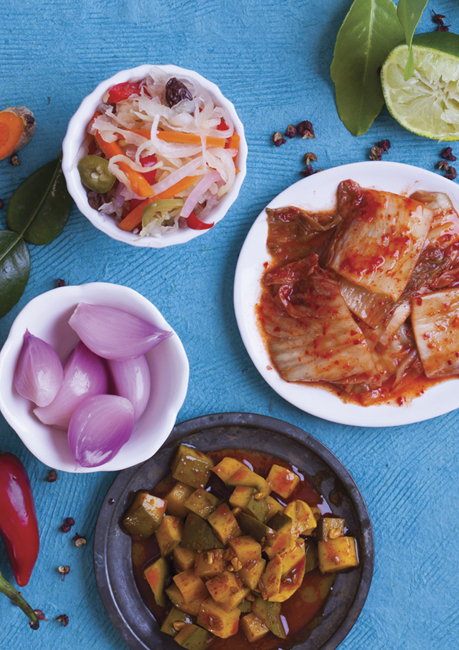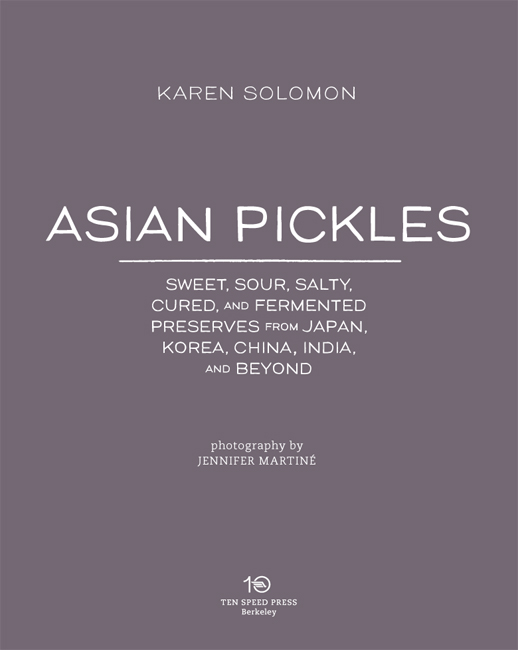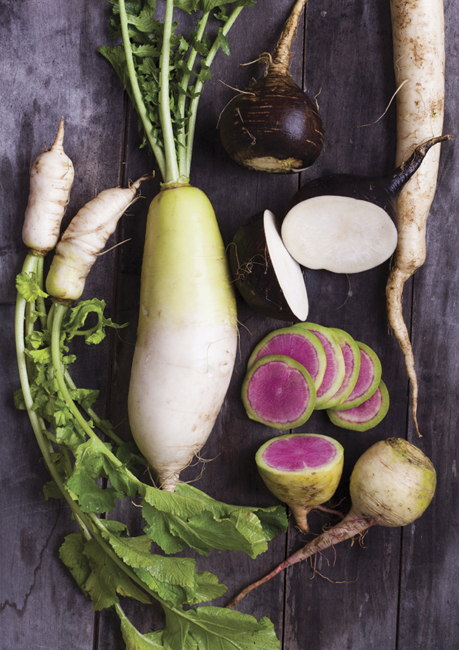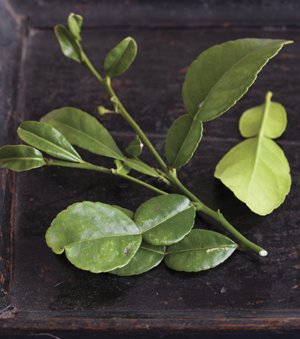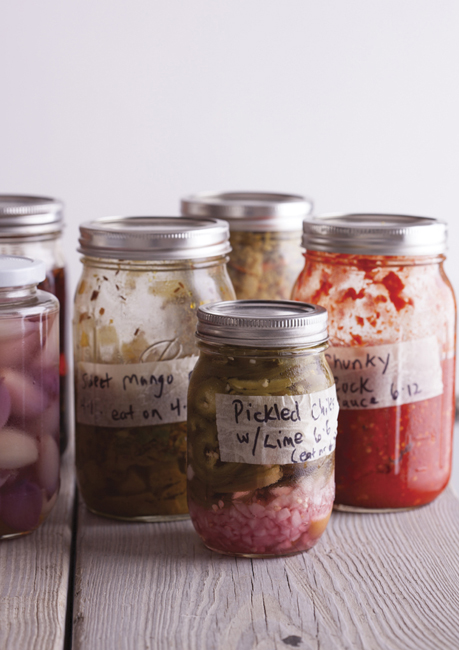Copyright 2014 by Karen Solomon
Photographs copyright 2014 by Jennifer Martin
All rights reserved.
Published in the United States by Ten Speed Press, an imprint of the Crown Publishing Group, a division of Random House LLC, a Penguin Random House Company, New York.
www.crownpublishing.com
www.tenspeed.com
Ten Speed Press and the Ten Speed Press colophon are registered trademarks of Random House LLC.
Some text and photos appearing herein were first included in ebooklets for Japan, Korea, China, and India published by Ten Speed Press, Emeryville, CA, in 2013.
Library of Congress Cataloging-in-Publication Data
Solomon, Karen.
Asian pickles : sweet, sour, salty, cured, and fermented preserves from
Korea, Japan, China, India, and beyond / Karen Solomon.
pages cm
ISBN 978-1-60774-476-4 (hardback) - ISBN 978-1-60774-477-1 (ebook)
1. PicklesAsia. 2. Cooking, Asian. I. Title.
TX805.S83 2014
641.462095dc23
2014002953
ISBN: 978-1-60774-476-4
eISBN: 978-1-60774-477-1
Food styling by Karen Shinto
Prop styling by Christine Wolheim
v3.1
CONTENTS
ACKNOWLEDGMENTS
T HE LIST OF THOSE TO THANK on this project is long and surely incomplete. First off, the Ten Speed crewMelissa Moore for her thoughtful editing and Katy Brown for her impeccable, best-ever book designand both for their Ghandi-like patience as every deadline went whizzing past me and for their general pleasant nature and support. Hats off also to Clancy Drake, who is not just a top-tier copyeditor but also a good luck charm. Her thumbprint is on every page. I spread this love further to food stylist Karen Shinto and photographer extraordinaire Jennifer Martin (aka The Dream Team) for their splendid efforts, once again, to make my food look supernatural. My agent, Danielle Svetcov, is a rock star who should manage every aspect of my life and not just my authoring. (Yes, she is that good.) Thank you, ladies, one and all. I could not have done this without you.
Recipe testers! You know who you are: Eve Lynch and Thy Tran. Thank you, thank you for picklemaking. All. Those. Damn. Pickles. Mary Rosberg (though you will always be Mary Choy to me), a million thanks to you and your mom, Keum Bong Kim, for your linguistic assistance. And another million arigato s to Mayumi Yoshida who was, quite literally, the voice of the Asian Pickles: Japan ebook. Thanks to Elaine Lin and Heather Snider for helping with Chinese tranlations. Thank you to Sandor Katz for pointing me toward that intoxicating tome on Chinese food history.
For inspiration, I offer my gratitude to chef Preeti Mistry and chef Sunhui Chang. If youre in the San Francisco Bay Area, I insist that you go eat at their restaurants, Juhu Beach Club and FUSEBox, both in Oakland. Kudos also to the Lee brothers of Namu Gaji in SF for your ambitious pickling program. Thank you to the staff of New Mae Wah market and the folks behind the awesome deli counter at Kukje Market. It is an oversight on my part that I cant name you here individually because so many of you deserve a moment in the spotlight for answering all of my silly questions. Amanda from Duc Loi market, also in San Francisco, makes the best bahn mi Ive ever had. Not only is she the nicest lady with the coolest life story, but also her pickle knowledge (and her kimchi) are off the charts. Thanks for the show and tell.
Thank you to my brother David for his enthusiastic pickle support; happy to do another all-fridge tasting anytime. Thank you to my beloved Matthew for being so tolerant of my army of jars and their mass refrigerator occupation. Thanks to my sweet ones, Emmett and Desmond, for tasting all of my sweet ones. Thank you to Mabel for lapping up all that spilled brine.
Thanks to YOU, my pickle-chomping audience, for your adventurous palate and briny lust. Lets DO this!
INTRODUCTION
M Y DEAR FELLOW PICKLING AFICIONADOS, given the choice of any global cuisine for nearly any meal of the day, my tastes and preferences will always point East. My meals include stir-fries, broths zupped up by preserved lemon or ginger, noodles of every imaginable type, savory pancakes, rice porridge, and, of course, several bowls of good ol Nishiki or jasmine steamed rice. My favorite brunch item ever is served at Namu Gaji in San Francisco: two sous vide eggs bobbing in an outstanding bowl of homemade dashi, served alongside rice, fried oysters, and house-made kimchi. That soothing, salty, full-flavored and fermented feast is what I crave.
Despite the fact that my first two cookbooks are always shelved with the jam making and canning books, I am a fan of kitchen tinkering of all stripes. I live for drying, salting, curing, marinating, and brining. I am simply fascinated by the meditative practice of taking a foodstuff and transforming it with little more than salt or sugar, heat or moisture, time and magical bacteria.
Enter the humble pickle. Although I love all of my kitchen creations the way a mother hen loves her flock, pickles have truly captured my heart (and my stomach!). I swear, I could live on little more than hot rice and cold pickles, provided they are crisp, flavorful, pungent, and bright. It is only natural that, with so many Asian flavors spilling from my dinner bowl plus so many years of traveling to Asia and living there for a spell, my interest would turn to pickles of the Asian continent. Although many of these pickles have clear and immediate appealafter all, who doesnt love fresh vegetables dunked in a bath of vinegar and sugar?it is the ones that have the most challenging flavors that I find the most pleasurable and rewarding. (Im looking at you , pickled squid, nukazuke, and achar!) Naturally, after tinkering in my own kitchen trying my hand at pickling in rice bran, soy sauce, citrus juices, and fish sauce, I set out to buy a cookbook that could teach me deeply about Asian pickles. While I found a few great books on pickles of individual countries, I did not find the pan-Asian pickling experience in recipe form, equipped with descriptions of ingredients and unfamiliar techniques, that I had a yen for. It was clear that I was going to have to write it instead.
So how did I set about on this global task? By stuffing my brain and my mouth full of every flavor of each country represented as much as possible. I set out on an epic research project: relying not just on personal experience from my own travels, but also other cookbooks, countless blogs, San Franciscos manifold authentic eateries and supermarkets, and friends, friends mothers, and grandmothers. I also pestered chefs and as many people working in the trenches as I couldliterally strangers who were experts at the craft and working behind deli cases, ringing cash registers, and waiting tablesto share their techniques, ingredients, and tips. And, of course, as any cookbook author will tell you, there is also nothing that can replace good ol trial and error. The kitchen-as-laboratory is always the best place to learn hands on (and fail a lot! Yes !).


